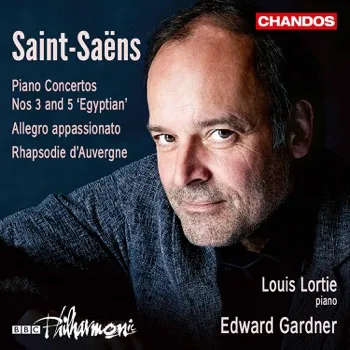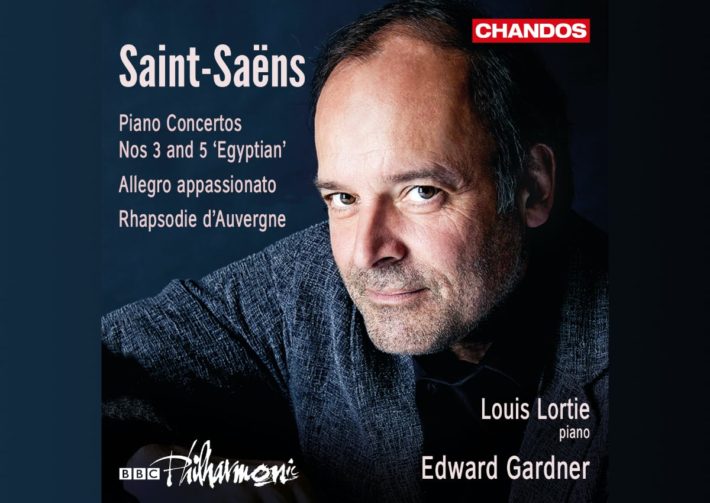This is the second of these forces’ complete Saint-Saëns concertante works for piano and orchestra. The first, containing Concertos Number 1, 2 and 4, received mixed reviews and, as in our review, was compared directly with the superb Chamayou recording of the Second and Fifths concertos for Erato.

As in the previous volume, Lortie can move from obscurity to lucidity, and both can be over-stated. To start with the Third Piano Concerto, Lortie and Gardner capture the perpetual energy and sweeping romance of the first movement, but hear the soloist-orchestra balance: in the opening, the fluid piano accompaniment is masked by the orchestra, robbing the section of depth and texture. Più Mosso indeed, but should it be that indistinguishable? Try the celebrated Stephen Hough in this opening and you’d find the orchestra and soloist mesmerizing while maintaining a superb clarity.
Lortie also has a slight tendency to rush through phrases, so the movement opening could have benefited from greater austerity and presence. In Pascal Roge’s recording (Decca, 1980), the soloist enters at a slower tempo and with distinct articulation, commanding the listener’s attention. Lortie’s over-pedaling makes many of his lines muddy and unstructured. The orchestra, too, does not shape its phrases as well as it could, thus giving the movement a one-dimensional feel. There are some good moments, however, such as the first cadenza that is both beautiful and powerful, the pianist pays careful attention to individual lines and their integration while maintaining sparkling sound quality.
Moving back to the lucid side of the spectrum, the second movement lacks expressive coordination: the sensitive orchestral opening is interrupted by an overly-present piano entrance and later on some of the piano melodies, particularly those in the lower register, sound a bit punchy. In the third movement, the piano opening should combine grace and charm with virtuosity, but Lortie powers through, over-pedaling again in the process. This movement also falls victim to one-dimensionality: orchestra and soloist alike sound heavy throughout, needing much more articulation and contouring of lines. In comparison, consider Alexandre Kantorow’s recording, reviewed on these pages last year: it not only makes much more use of dynamics but has a delightfully whimsical quality and scintillating clarity.
Piano Concerto No. 5 (“Egyptian”), written almost 30 years after No. 3, shows Saint-Saëns’ musical maturity and vitality of character. Lortie’s interpretation is regretfully wanting in imaginativeness. At the beginning of the first movement, he shows large-scale phrasing but plays too fast, not capturing the details of the two-note phrases that make up the larger line. Bertrand Chamayou takes a considerably more measured tempo, but these small phrases are clearly heard, lending a delicacy to his playing. The middle section features some of Saint Saëns’ most beautiful writing, and this is a moment where the soloist wants to have an expressive presence. Lortie does try to show subtle nuances, but ends up sounding subdued and thin.
The second movement is probably the strongest here: the contrast in characters between the dramatic opening, lyrical middle, and mysterious ending is well executed. The beginning, however, is problematic. The series of repeated E’s in the opening piano line are not just sharp but forceful to the point of harshness. Jean-Yves Thibaudet’s 2007 recording keeps these notes at the same volume, but the method of approach to the keyboard lends a totally different result: one that is round and full. Despite the rocky beginning, Lortie expresses the mysterious moments well, paying attention to the composer’s interesting harmonic and intervallic colors. The orchestra also has its good moments, with particularly lovely playing in the lyrical G major section (4’52”).
In the third movement of the “Egyptian”, tempo is a major issue. Playing too fast, Lortie sound machine-like; both Chamayou and Thibaudet take slower tempos, providing a necessary clarity of sound that inspires playful elegance. Soloist and orchestra do finally capture the true spirit of the movement a little later on. At 2’05”, the melodic interchanges between oboe and cello is seamless; Lortie’s clean and even accompaniment complements this dialogue well.
The shorter works fare better: “Rhapsodie d’Auvergne” is lovely with its reflective and meditative moments. The “Allegro Appassionato” puts Lortie’s virtuosity on display with a combination of elegance and drama. But one should perhaps look elsewhere for a more inspirational interpretation, particularly of the concertos.
Saint-Saëns – Piano Concertos No. 3, 5, Rhapsodie d’Auvergne, Allegro appassionato
Louis Lortie – Piano
BBC Philharmonic
Edward Gardner – Conductor
Chandos, CD CHAN 20038




















